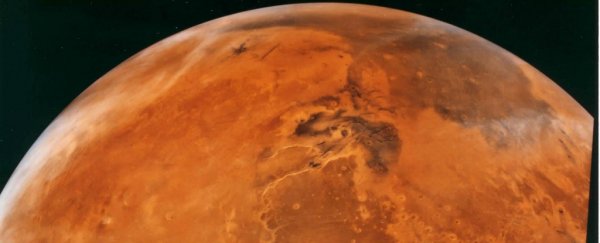Update 29 September: It's official, NASA has found evidence of liquid water flowing on the surface of Mars.
NASA has scheduled a press conference for Monday morning in the US, and its researchers are going to be revealing a "major science finding" about Mars to the public. If you're as psyched about that as we are, you can watch the announcement live at the bottom of this story at 11.30am EDT (3.30pm UTC and 1.30am AEST on Tuesday morning).
Speculation is rife about what the announcement may involve, and we certainly don't want to jump to any conclusions, but so far there are some pretty solid signs that the finding will be to do with evidence of liquid water on the Red Planet.
One big clue is the panellists involved, which NASA outlined in its press release on Friday:
- Jim Green, director of planetary science at NASA
- Michael Meyer, lead scientist for the Mars Exploration Program
- Lujendra Ojha of the Georgia Institute of Technology in Atlanta
- Mary Beth Wilhelm of NASA's Ames Research Centere
- Alfred McEwen, principal investigator for the High Resolution Imaging Science Experiment
Of particular interest are Ojha and McEwen, who are also presenting research at the European Planetary Science Congress on Monday, as Phil Plait pointed out over at his blog on Slate. Their paper at the conference is on mysterious recurrent gullies that appear and disappear seasonally in crater walls on Mars. They're mysterious because they seem to have been carved out by water.
At the European conference, Ojha and McEwen are also going to be reporting that they've found the presence of salts in these gullies, which could be caused by water seepage.
It seems highly likely that both of these results will be a big part of the NASA press conference, because until now we've not seen any evidence that liquid water is still present on Mars.
So what's the deal with these gullies? Phil Plait explains over on Slate:
"As far back as 2007, NASA announced they might be from water, though a year later a study was released indicating many might be better explained as dry grains flowing downhill. In 2010 more gullies popped up that looked like they could be from liquid flowing, but the evidence was still a bit circumstantial. We know water once flowed on Mars, a long time ago, and there's plenty of evidence for ancient standing lakes and even oceans. Also, even now there's lots of water ice just below the surface across a wide range of latitudes, too."
So how would liquid water get on Mars? Because salty water melts at a lower temperature than fresh water, the frozen salt water below the surface of these crater walls could be heating up enough in the spring months to melt and seep out to the surface, Plait suggests.
But this wouldn't explain how that sub-surface ice is being replenished each year, and so Ojha and McEwen suggest that the water may actually be caused by deliquescence, which means water is being absorbed from the atmosphere.
Before you get too excited, neither of those options would really make the possibility of life existing on Mars more likely. But simply knowing that liquid water may still be present on the Red Planet would be a huge deal, and may have an impact on our future colonisation plans.
We'll find out a whole lot more in a few hours, so make sure you watch the live stream below, via NASA Public TV, from 11.30am EDT (3.30pm UTC and 1.30am AEST). And we'll be reporting back first thing Tuesday morning (Sydney time) with all the news from the briefing.
Update 29 September: It's official, NASA has found evidence of liquid water flowing on the surface of Mars.
Broadcast live streaming video on Ustream
